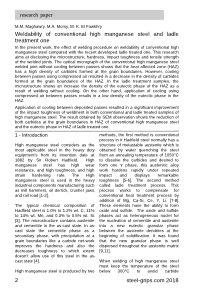In the present work, the effect of welding procedure on weldability of conventional high manganese steel compared with the recent developed ladle treated one. This research aims at disclosing the microstructure, hardness, impact toughness and tensile strength of the welded joints. The optical micrograph of the conventional high manganese steel welded joint without cooling between passes shows that the heat affected zone (HAZ) has a high density of carbides formed at the grain boundaries. However, cooling between passes using compressed air resulted in a decrease in the density of carbides formed at the grain boundaries of the HAZ. In the ladle treatment samples, the microstructure shows an increase the density of the eutectic phase of the HAZ as a result of welding without cooling. On the other hand, application of cooling using compressed air between passes results in a low density of the eutectic phase in the HAZ.
Application of cooling between deposited passes resulted in a significant improvement of the impact toughness of weldment in both conventional and ladle treated samples of high manganese steel. The result obtained by SEM observation shows the reduction of both carbides at the grain boundaries in HAZ of conventional high manganese steel and the eutectic phase in HAZ of ladle treated one.

